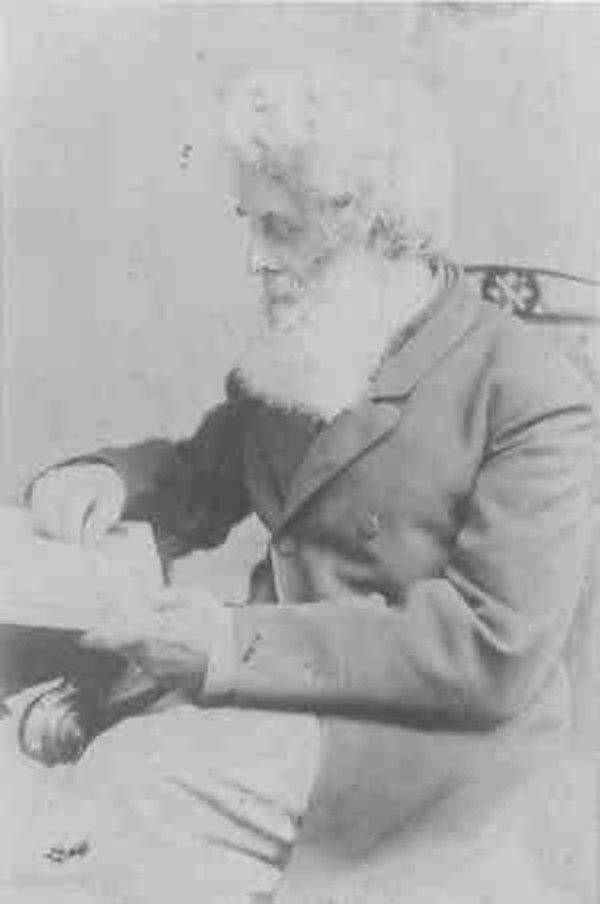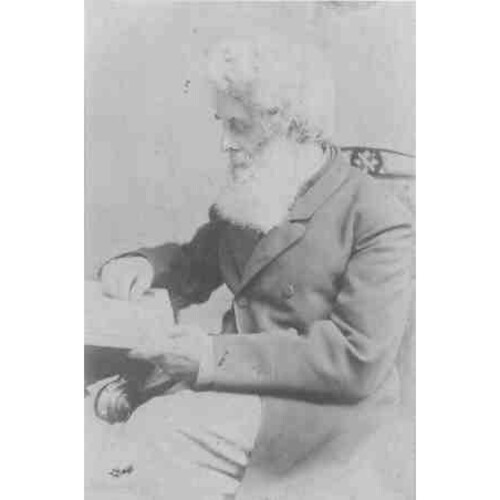
Source: Link
ASHE, EDWARD DAVID, naval officer, astronomer, writer, and office holder; b. c. 1813 in Bath, England; m. 28 May 1851 Marcella Percy at Quebec, and they had four daughters and four sons; d. 30 March 1895 in Sherbrooke, Que.
Edward David Ashe entered the Royal Navy on 20 March 1830 and, after studying gunnery at Portsmouth, England, successfully passed his examination in 1836. The following year he was posted as mate on the Daphne, and he served in the Mediterranean until 1840. During his training he had shown an aptitude for mathematics and mechanics; soon after, he devised a new method for concentrating ship’s fire, the trials of which, undertaken in 1841, were deemed highly successful. Commissioned lieutenant on 25 May 1842, he was for a few months an officer on the Excellent; he was transferred to the Fisgard in May 1843 and later to the Daphne, both serving in the Pacific. In 1847 Ashe Head, in Esquimalt Harbour (B.C.), was named for him. By August 1849, in a shipboard accident, Ashe had suffered a fracture of the thigh that made him a lifelong invalid. He was offered the directorship of a proposed observatory at Quebec.
The observatory, a project of the Canadian government, was designed to provide accurate time to the port of Quebec. Ashe arrived in November 1850, bringing with him instruments from the Royal Observatory, Greenwich (London), England. After making alterations to the observatory building, he took charge in 1851. His duties initially were to observe star transits and to drop a time-ball daily. During the winter of 1856–57, at the request of Sir William Edmond Logan* of the Geological Survey, he established the longitudes of Montreal, Toronto, Kingston, and several Canadian towns with respect to Quebec. In the autumn of 1857, realizing that the longitude determined for Quebec was insufficiently accurate, he revised Canadian longitudes by exchanging time signals via telegraph, a novel technique, with William Cranch Bond of the Harvard College observatory.
Ashe was also interested in observing the sun. He accompanied an American expedition to Cape Chidley (N. W. T./Labrador) in 1860 to study sunspots using the Quebec observatory’s small telescope. From the mid 1850s he lobbied the government repeatedly for a larger telescope of research capabilities; he finally succeeded in 1865 in obtaining an excellent instrument. He soon became one of the world’s first experimenters in astronomical photography, and his solar photographs were admired by the ranking solar astronomers of England, including Warren De La Rue. In 1869 Ashe led a small party to Jefferson City, Mo., to observe a total solar eclipse. His photographs of the event, different from those of other observers, touched off an enduring controversy; Ashe noted “bent-over” prominences which were questioned by De La Rue but confirmed by others. He continued his photographic experiments during the following decade. In 1867 he had published a theory of sunspots in the Monthly Notices of the Royal Astronomical Society (of which he was a fellow). It, too, had been controversial and, in fact, was soon proved incorrect. In 1875 Ashe ascertained a number of longitudes along the Ottawa River on behalf of the Quebec Crown Lands Department.
Ashe’s research and ideas were not restricted to astronomy. His comments on a new method of “great circle sailing” were solicited by General Sir John Fox Burgoyne in 1858, he designed a life-raft, and he provided detailed plans for the observatory and time-ball for the port of Saint John, N.B., in 1869. An active member of the Literary and Historical Society of Quebec (he was vice-president in 1854 and president in 1866, 1867, and 1873), he presented papers and wrote articles on such disparate topics as the rotation of the earth, water power, insurrections in Jamaica, and the moral and political position of women. He was also a popular public speaker at Quebec. In 1861 Ashe had been named a commissioner for the relief of shipwrecked and destitute sailors, and in 1865 he had been promoted commander on the Royal Navy’s retired list.
Ashe’s last major work at the Quebec observatory was the preparation for observing the transit of Venus in 1882. Four years later a son, William Austin, replaced him as director. Ashe resided briefly in Lennoxville and then moved to Sherbrooke about 1890; he died there in 1895. Frustrations in his dealings with government and controversies over the value of his solar photography and theories notwithstanding, Ashe had proved to be a resourceful and productive scientist. In particular, his determinations of longitude laid the groundwork for the subsequent half-century of practical astronomy in Canada, and his solar researches mark him as Canada’s first astrophysicist.
Edward David Ashe is the author of numerous articles on scientific subjects, including the following. In Canadian Journal of Industry, Science, and Art (Toronto) he published: “On the employment of the electric telegraph in determining the longitude of some of the principal places in Canada,” new ser., 4 (1859): 453–65; in Geological Survey of Canada, Report of progress (Toronto): “On the longitude of some of the principal places in Canada as determined by electric telegraph in the years 1856–57,” 1857: 231–40; in Literary and Hist. Soc. of Quebec, Trans.: “The late eclipse: journal of a voyage from New York to Labrador,” “Water power of Quebec,” and “Plan of the construction of a raft to rescue passengers from sinking ships,” 4 (1843–60): 1–16, 229–35, and 237–41 respectively; “Notes of a journey across the Andes,” 5 (1862–63): 3–35; “Motions of the top, teetotum, and gyroscope” and “Results of observations for the determination of the latitude of the Observatory,” new ser., 2 (1863–64): 94–104 and 159–60 respectively; “On solar spots,” new ser., 5 (1866–67): 5–14; “On the physical constitution of the sun,” new ser., 6 (1867–69): 41–44; and “The Canadian eclipse party, 1869,” new ser., 7 (1869–70): 85–110; and in Royal Astronomical Soc., Monthly Notices (London): “On determining the longitude at sea from altitudes of the moon,” 12 (1851–52): 179–80; “On the pendulum experiment for illustrating the rotation of the earth,” 15 (1854–55): 93; “Physical constitution of the sun,” 26 (1865–66): 61–62; “On a plan for fixing the position of solar spots,” 27 (1866–67): 274–75; “Solar eclipse of 7th August 1869” and “On his photographs taken during the total solar eclipse, Aug. 7, 1869,” 30 (1869–70): 3 and 173–74 respectively.
AC, Saint-François (Sherbrooke), État civil, Anglican, St Peter’s Church (Sherbrooke), 1 April 1895. ASQ, Univ., cartons 83, no.29; 101, no.AS. Harvard College Library, Houghton Library (Cambridge, Mass.), G. P. Bond papers; W. C. Bond papers. NA, MG 26, A: 179317–18; RG 4, C1, 273, 290, 292, 303; RG 93, 82. Can., Prov. of, Legislative Assembly, App. to the journals, 1849, app.MMM. Gazette (Montreal), 1 April 1895. Le Pionnier, 5 avril 1895. Quebec Daily Mercury, 1 March 1864. Canadian men and women of the time (Morgan; 1898). Dominion annual reg., 1885. R. A. Jarrell, The cold light of dawn: a history of Canadian astronomy (Toronto, 1988); “Origins of Canadian government astronomy,” Royal Astronomical Soc. of Canada, Journal (Toronto), 69 (1975), no.2: 77–85. “L’observatoire de Québec,” BRH, 42 (1936): 16–18.
Cite This Article
Richard A. Jarrell, “ASHE, EDWARD DAVID,” in Dictionary of Canadian Biography, vol. 12, University of Toronto/Université Laval, 2003–, accessed December 31, 2025, https://www.biographi.ca/en/bio/ashe_edward_david_12E.html.
The citation above shows the format for footnotes and endnotes according to the Chicago manual of style (16th edition). Information to be used in other citation formats:
| Permalink: | https://www.biographi.ca/en/bio/ashe_edward_david_12E.html |
| Author of Article: | Richard A. Jarrell |
| Title of Article: | ASHE, EDWARD DAVID |
| Publication Name: | Dictionary of Canadian Biography, vol. 12 |
| Publisher: | University of Toronto/Université Laval |
| Year of publication: | 1990 |
| Year of revision: | 1990 |
| Access Date: | December 31, 2025 |



